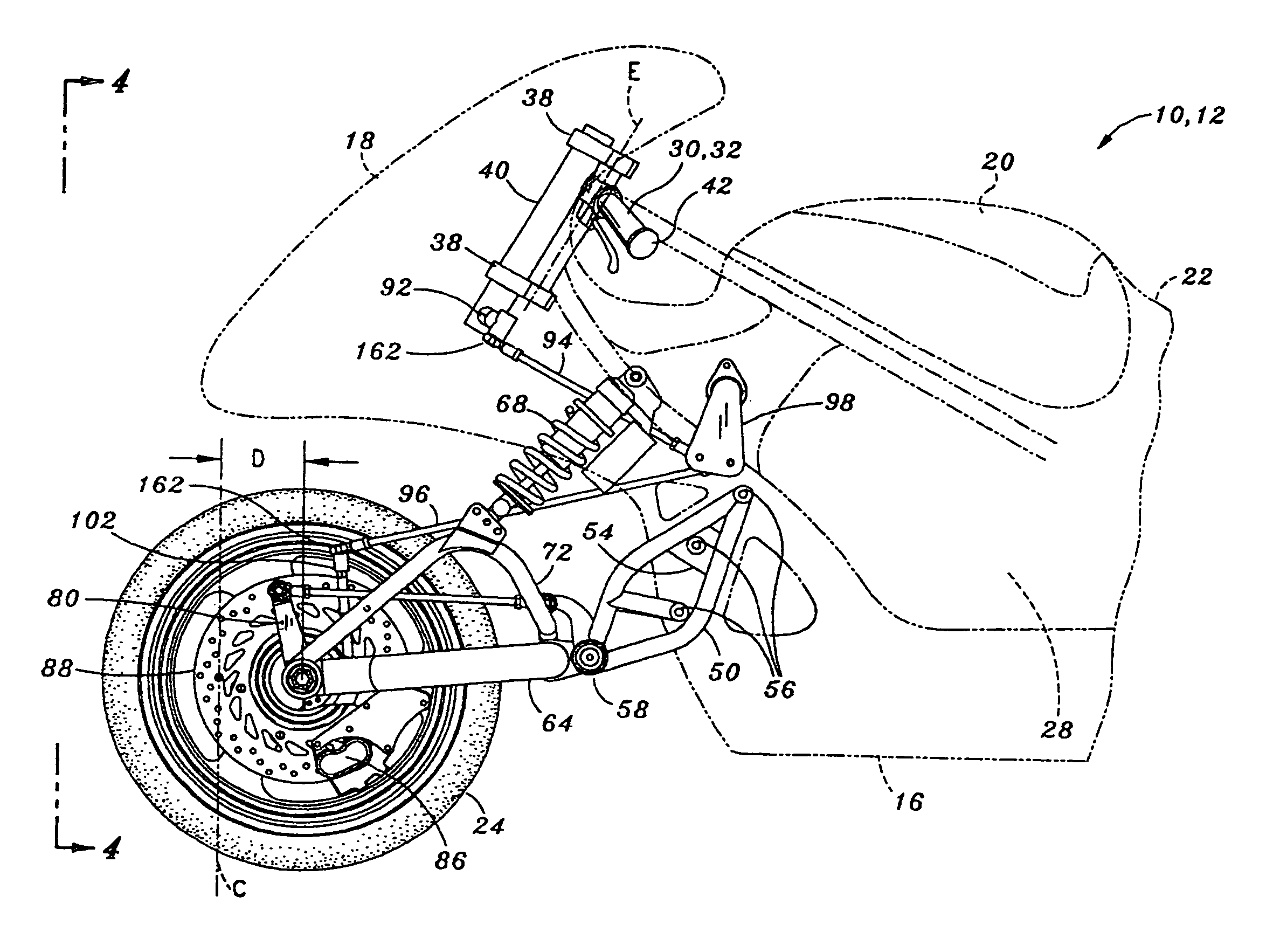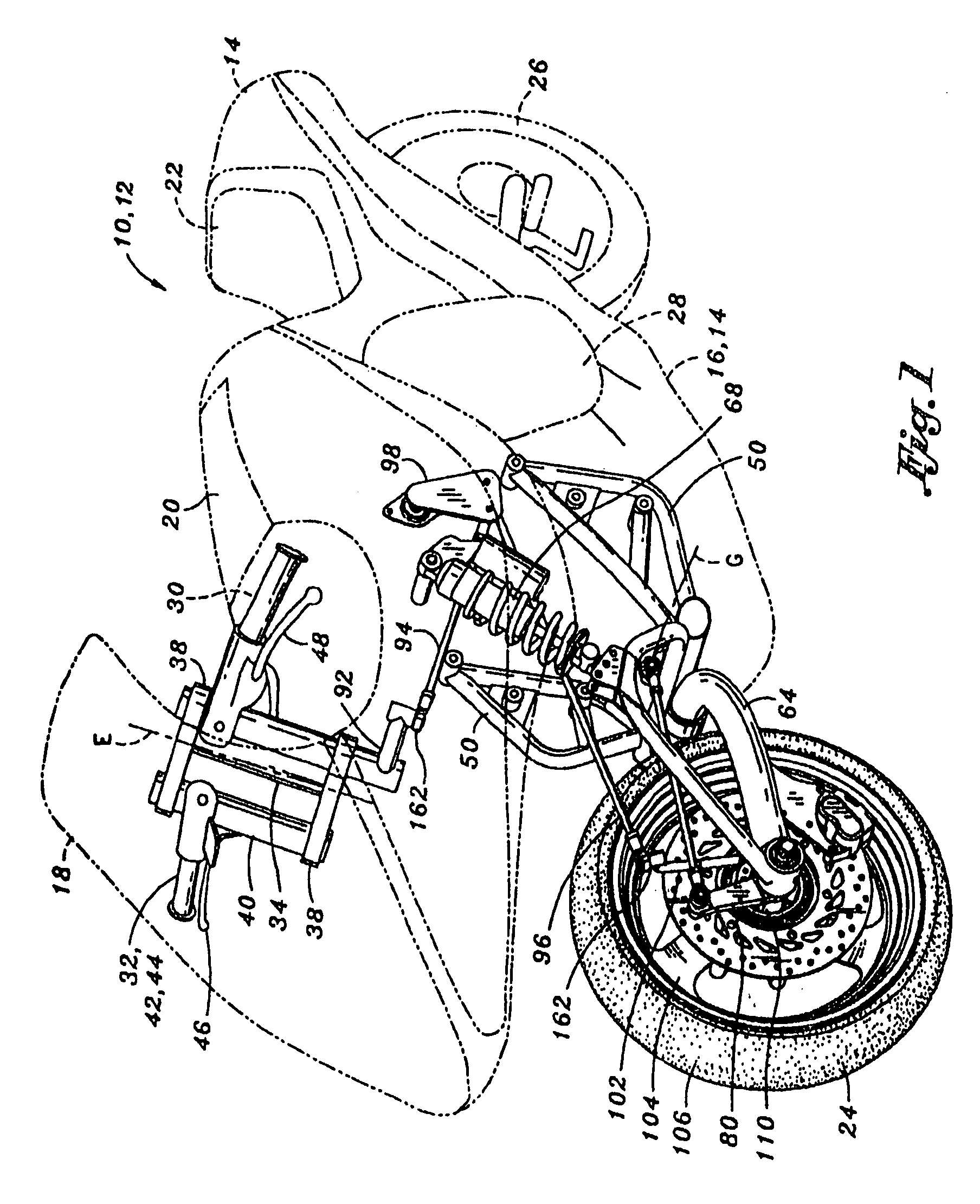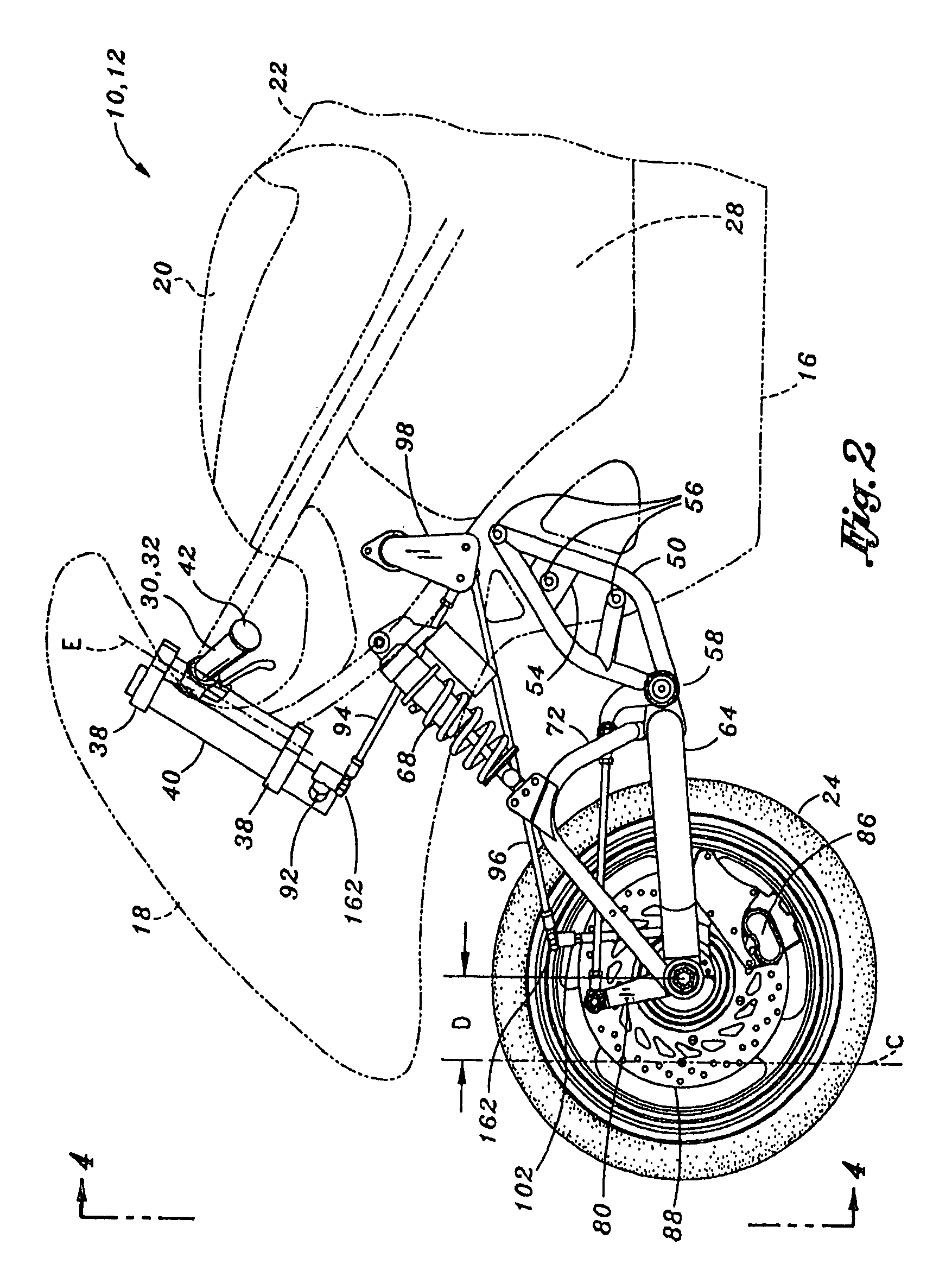Although the telescopic front fork
system has been successfully incorporated into a majority of motorcycles produced up to the present, conventional telescopic forks suffer from several deficiencies which detract from their overall utility.
The ability to
resist undue flexing unfortunately results in an increase in weight of the front forks and motorcycle frame.
Another
disadvantage associated with the front telescopic forks of conventional motorcycles is that the point of the steering stem where the front forks are connected to the motorcycle frame is positioned substantially above the motorcycle center of gravity.
The relatively high connection point of the front forks further raises the center of gravity which has the unfortunate effect of reducing handling performance of the motorcycle and especially during low-speed maneuvering or when the motorcycle is at rest and supported only by the rider.
A further drawback associated with conventional telescopic forks of the prior art is related to the tendency of the front end of the motorcycle to dive under heavy braking as the weight of the motorcycle is transferred to the front wheel.
During front-end dive, the compression springs in the front forks are further compressed which reduces the ability of the compression springs to absorb and dissipate irregularities or bumps in the road during braking.
In extreme cases, the phenomena of front-end dive presents a safety issue as the motorcycle can potentially flip forward under severe braking.
However, the user of stiffer springs has the unfortunate counter-effect of decreasing the capability of the front fork to dissipate smaller bumps during non-braking maneuvers.
However, the BMW Telelever™
system mounts and transfer loads to the upper portion of the frame and therefore fails to address other problems associated with conventional front fork suspension systems.
Such problems are related to front-end dive and include an increase in pressure at the
contact patch of the front tire during braking which, in turn, increases the
bending moment forces experienced at the steering head.
The need to
resist bending results in an increase in the
mass of the steering stem and its attach points.
Although a certain amount of
weight transfer to the front end may be desirable in order to provide a desired amount of pressure on the front tire to temporarily increase the
contact patch area and prevent front wheel sliding, an excess amount of front-end dive will result in reduced braking capability at the rear wheel to the extent that the overall braking performance of the motorcycle is adversely affected.
Another drawback associated with telescopic front forks is related to the high
moment of inertia as a result of the large
mass of the suspension and front wheel
assembly rotating about the steering axis.
The high
moment of inertia can result in the development of a violent wobble at the front wheel at certain speeds.
Although many manufacturers include a steering dampener to dampen oscillations occurring as a result of wobble, the added steering dampener unfortunately only further increases the weight and cost of the motorcycle.
Conventional telescopic forks also suffer from the inability to provide a manner for adjusting the spring rate of the compression springs to accommodate varying types of
terrain, varying rider styles and varying riding conditions.
Unlike conventional rear suspension systems for motorcycles which typically include an exterior mounted compression spring which is relatively accessible, compression springs of telescopic front forks are typically inaccessibly located inside the fork tubes and are not easily adjustable without completely disassembling the forks and completely removing the compression springs.
A further drawback of conventional telescopic front forks of motorcycles is associated with the angle at which the steering stem and forks are oriented relative to vertical and which is commonly referred to as the
rake angle.
Unfortunately, road imperfections which induce off-centered upward forces on the front tire have a tendency to steer the wheel.
For example, when encountering a longitudinal
rut or groove in the riding surface parallel to the direction of movement of the motorcycle, a high
rake angle also makes it difficult for the rider to steer the front wheel out of the
rut.
In addition, the self-steer effect also causes the motorcycle to drift toward a lower portion of the riding surface on crowned roads making it difficult to steer the motorcycle out of the lower portion.
A further problem associated with
rake angle is related to the fact that during front-end dive, the telescopic forks collapse or effectively shorten, the wheel base (i.e., the distance between the front and rear wheels of the motorcycle) becomes proportionally shorter.
Such reduced
wheelbase unfortunately decreases the straight-line stability of the motorcycle.
An additional problem associated with rake angle of conventional front fork systems is a tendency of the rake angle to steepen or decrease during front-end dive which unfortunately causes a decrease in trail which is defined as the distance between the front tire
contact patch and the point at which the front fork axes intersect the ground.
A reduction in the trail as a result of front-end dive results in a decrease in the steering stability of the motorcycle.
As is the case with the compression springs in the front forks, the amount of trail of the front wheel is typically preset by the manufacturer and is not easily modified to provide different handling characteristics as may be desired for varying riding conditions.
Yet another drawback associated with rake angle is a the occurrence of a lowering of the motorcycle center of gravity in proportion to an increasing
steering angle at the front wheel.
Telescopic fork systems suffer a further
disadvantage which is related to the relatively large amount of suspension travel that is designed into the motorcycle in order to allow the front wheel to deflect sufficiently when encountering certain
terrain conditions and obstacles.
Unfortunately, the relatively large amount of front-end dive experienced by motorcycles equipped with conventional front forks necessitates a correspondingly large amount of front wheel travel which, in turn, increases the overall frontal area of the motorcycle and the attendant
aerodynamic drag at speed.
 Login to View More
Login to View More  Login to View More
Login to View More 


